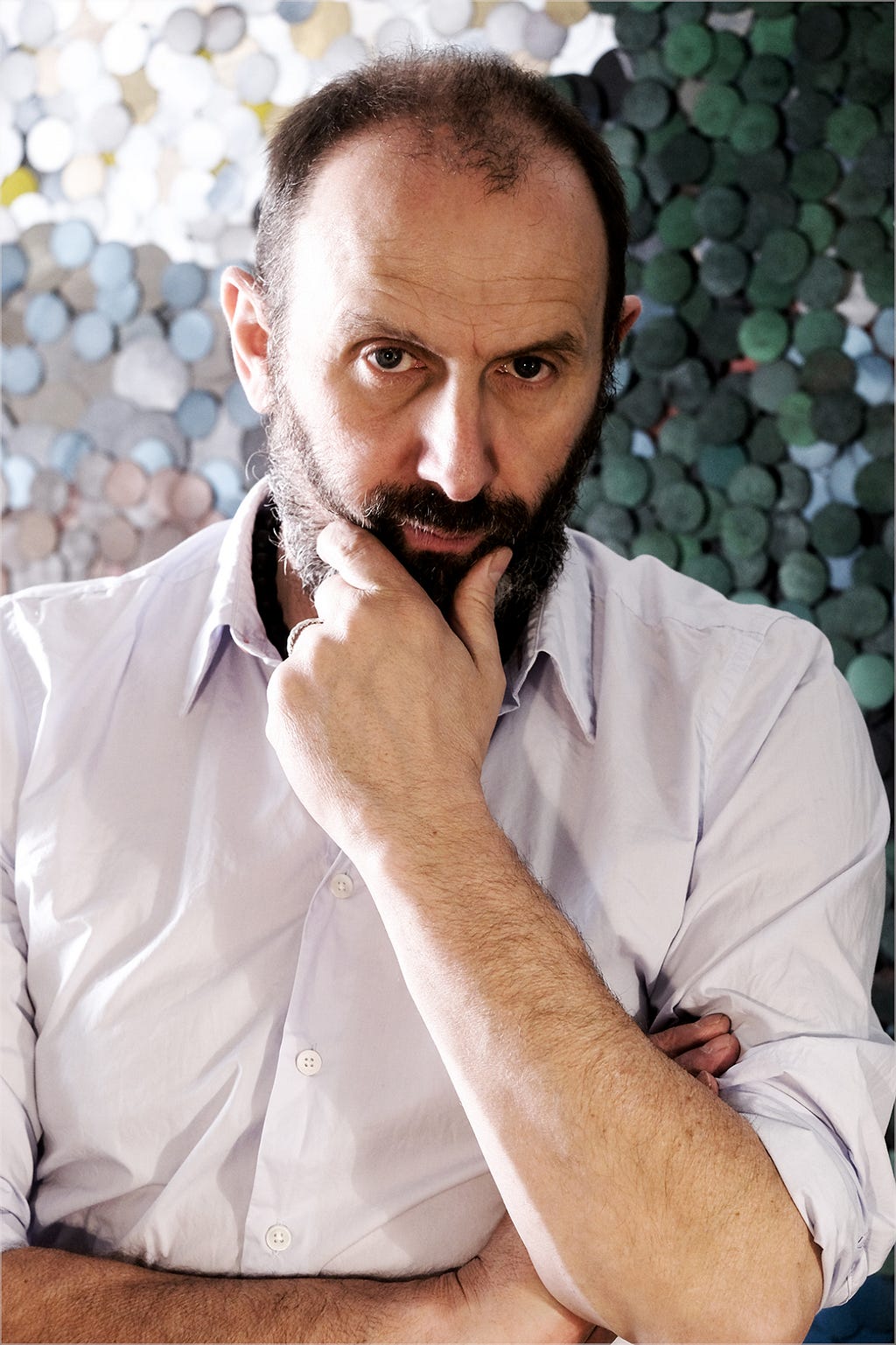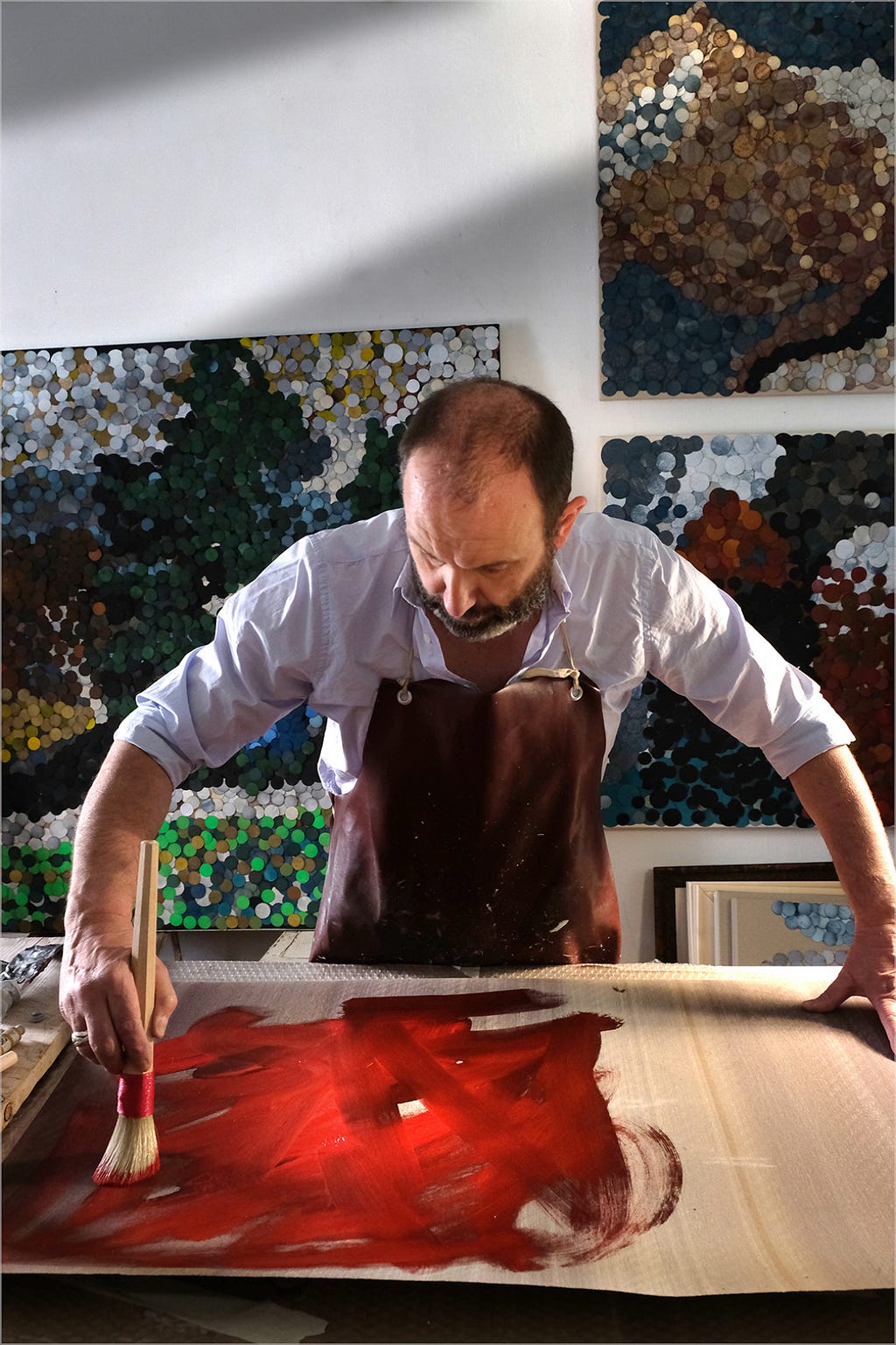
Bad influences. — In my history as an artist I have sometimes followed bad teachers and let myself be influenced by critics and gallery owners, hoping to be able to make a change. I eventually realized that all this was distracting me from my research. Better to proceed on your own path, without letting yourself be influenced too much.
As a part of our series about “5 Things I Wish Someone Told Me When I First Became An Artist” I had the pleasure of interviewing Oscar Baccilieri.
Si prega di inserire qui la tua biografia di tre frasi con il tuo nome, azienda e risultati ottenuti.
Oscar Baccilieri (1965, Reggio Emilia) is a visual artist, graduated in 1991 in Painting with Concetto Pozzati at the Academy of Fine Arts in Bologna.
Observing reality and reconstructing meaning, Oscar plays with traditional and innovative artistic techniques, from collage to etching of copper to painting on used sandpaper stickers applied as a mosaic on raw canvas, experimenting with different unconventional materials including cashmere, beeswax, marble, absorbent paper and more. Inspired by childhood, he addresses issues related to truth, perception, imagination, as well as memory formation, with a playful and curious approach that leads to an ironic or provocative component.
Thank you so much for doing this with us! Can you tell us the story of how you grew up?
The only child of a family with limited economic resources near Reggio Emilia city, in Italy, I received no encouragement towards art, but I always wanted to become an artist. For this reason, after the middle school I attended first the Art Institute in my town and then the Academy of Fine Arts in Bologna.
Can you share a story with us about what brought you to this specific career path?
As a child I vented my creativity with any object I came across, so during my artistic training I continued with this natural propensity for materials, letting myself be guided by their intrinsic characteristics or trying to contaminate them with each other and with what I learned about art.
Can you tell us the most interesting story that happened to you since you began your career?
Among the various things I have achieved, the foundation of the artistic group “Mistiche Nutelle” in 1990 represented a turning point for my artistic career. In that period various collectives or groups were born, such as “Plumcake”. Our first public appearance was at the Palazzo dei Diamanti in Ferrara, then under the direction of Franco Farina who loved our work and gave us free reign. Franco Farina was also the first to bring Andy Warhol to Italy and, not surprisingly, Warhol himself claimed that the director was the only one in Italy who understood anything about art!
What are some of the most interesting or exciting projects you are working on now?
I recently moved to a larger studio. Here I have greater freedom of movement and thought, and I can work on multiple projects together, even large ones.
I have just completed the “Nano-Nano” series, a cycle of 7 large sandpaper collages on canvas about the relationship between dictatorship and freedom.
Walt Disney’s Seven Dwarfs are here both the personification of devious American-style capitalism and the guardians of totalitarian regimes. On a background of Byzantine-derived golden tiles, each character retains their distinctive features and classic cinematic iconography, but carries in their hands the symbols of the main regimes in history.
It was a long and demanding job, meaningful and fun at the same time.
Furthermore, we are preparing the next exhibition by the group “Mistiche Nutelle”: GOOD VIBRATIONS — MUSIC FOR YOUR EYES is an ironic and irreverent show that offers a personal reading of the most iconic music and everything that revolves around it. It will open on March 15, 2024, at the Spazio Gerra in Reggio Emilia. I can’t wait for it!
Who are some of the most interesting people you have interacted with? What was that like? Do you have any stories?
I was lucky enough to study with Concetto Pozzati, a great master of Italian Pop Art. Pozzati was a great communicator and theorist, and his lessons were always full of hidden meanings.
From him I learned to roam around art, continuously intertwining things, styles and materials together, and to desecrate art using irony to save oneself from falling.
To this day, the Maestro continues to be a constant presence in my everyday art making.
Where do you draw inspiration from? Can you share a story about that?
My first source of inspiration is the history of art itself, its evolution and the work of great artists of yesterday and today, from Piero della Francesca to David Hockney, from romantic landscape artists to pop and dada.
The spark that drives me to create a specific work of art, however, almost always comes from encounters or situations that actually happened, which set in motion a series of reflections that I elaborate on with my artistic vision.
For example, the “Nano-Nano” series would not have existed without the pandemic. This project was born from the sensations felt and the facts experienced during the lockdown, both personal and collective. I thought about the best way to communicate my thoughts to other people, and I combined classic and cult elements.
How have you used your success to bring goodness to the world?
Today’s world is increasingly complex, interconnected and chaotic.
Through art I talk about this society while remaining focused on important themes, such as childhood, memory and the sacred. So I also help those who observe it not to lose their compass.
My subjects are both figurative and abstract, depending on technique and material, and always deal with truth.
I often play down elements thanks to irony and lightness: art must be aesthetically and internally enjoyable, only in this way is it possible to trigger true processes of awareness.

What are your “5 things I wish someone told me when I first started” and why. Please share a story or example for each.
1. “A Room of One’s Own”
Having a space in which to create your own works is a sign of emancipation, professionalism and deep respect for what you do.
2 . Bad influences.
In my history as an artist I have sometimes followed bad teachers and let myself be influenced by critics and gallery owners, hoping to be able to make a change. I eventually realized that all this was distracting me from my research. Better to proceed on your own path, without letting yourself be influenced too much.
3. Good reputation
Patty Smith said that a good name is an artist’s currency. So don’t worry about making money and being successful, but do good work.
4. Sharing and connections
Keeping close to your traveling companions (colleagues, critics, gallery owners, journalists…) with whom you grew up helps each artist not to isolate himself too much and to cultivate a stimulating discussion on shared socio-cultural roots.
5. Bread and onion!
Don’t wait, get involved now! Bet everything on your art, even at the cost of some deprivation, to do what you like.
You are a person of great influence. If you could inspire a movement that would bring the most amount of good to the most amount of people, what would that be? You never know what your idea can trigger. 🙂
I would like my art to bring joy to as many people as possible.
Art is beauty and culture, and these two things united together can make a fundamental contribution and create incentives to make the world more beautiful.
Stimulating others to culture and art generates the spark that can move humanity forward in a more sustainable direction.
We have been blessed that some of the biggest names in Business, VC funding, Sports, and Entertainment read this column. Is there a person in the world, or in the US whom you would love to have a private breakfast or lunch with, and why? He or she just might see this.
One of the artists who influenced me most since my early years at the Academy was David Hockney, master of English Pop Art. I would really like to meet him and share my ideas with him.
Another person who influenced me a lot in the artistic field was David Byrne, who in addition to being a great musician is also a fabulous visual artist.
What is the best way our readers can follow you on social media?
On Instagram you can find the works, exhibitions, inspirations and news regarding my research.
@oscarbaccilieri : https://www.instagram.com/oscarbaccilieri/
This was very inspiring. Thank you so much for joining us!
Oscar Baccilieri: 5 Things I Wish Someone Told Me When I First Became An Artist was originally published in Authority Magazine on Medium, where people are continuing the conversation by highlighting and responding to this story.
